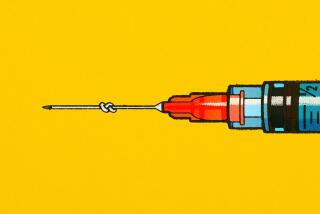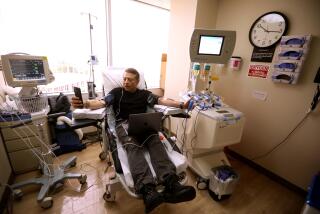Beat the Clock
Suppose Juan Ponce de Leon--who died in 1521 after cruising the Florida coast looking for that elusive Fountain of Youth--returned today.
He’d have some hefty decisions to make about turning back the clock. Should he take a hormone cocktail or a handful of antioxidants? Or maybe an herbal remedy? Perhaps a Chin Gym or a face mask with magnets to firm and tone?
Anti-aging medicine is “no longer alternative medicine--it’s cutting-edge,” says Dr. Ronald Klatz, who is admittedly a bit biased. As president of the American Academy of Anti-Aging Medicine, founded in 1993, he’s watched the organization grow from 12 physicians to 1,300. Soon, the academy plans to board-certify physicians who want to specialize in anti-aging medicine.
The same boom has hit in entrepreneurial circles. “In the last five years, sales of anti-aging products have increased from 10% to 30% of our business,” says Tony Farrell of Self Care, an Emeryville, Calif.-based mail-order catalog that sells the Chin Gym, an ab toner, anti-wrinkle patches and other gadgets.
Klatz estimates that Americans spend $1 billion on nutritional and drug anti-aging treatments. As options grow and interest blooms, however, it’s increasingly difficult to separate hope from hype. Here’s a partial scorecard on what advocates say can be done to outwit birthdays, along with skeptics’ input and the federal government’s view.
*
Antioxidants are perhaps the most respected anti-aging option. “Probably the strongest science is behind the antioxidants,” says Klatz, especially vitamins A, C, E and selenium. Antioxidants prevent the havoc wreaked by substances called “free radicals,” which, left unchecked, can damage cells and lead to cancer, heart disease and other age-related ailments.
“The business of taking antioxidants--and vitamins in general, although not proven--seems to be prudent,” says Vincent Cristofalo, director of the Center for Gerontological Research at Allegheny University of the Health Sciences in Philadelphia and president of the American Federation for Aging Research in New York.
Unless consumers self-prescribe megadoses, he adds, the antioxidants are “relatively innocuous.”
In one of the latest studies, selenium was found effective in protecting against cancers of the lung, colon, rectum and prostate, but not in protecting against those of the skin, bladder, head and neck or breast. In the study, partially funded by a firm that supplies raw materials to vitamin companies and published last week in the Journal of the American Medical Assn., 1,312 subjects with previous skin cancers took 200 micrograms of selenium a day and were followed up for more than six years.
Depending on formulas, a month’s supply of antioxidants can cost $20 to $40.
*
In the “less-proven” category, at least according to some experts, are treatments often touted by advocates as breakthroughs.
The hormone DHEA (dehydroepiandrosterone), produced by the adrenal gland, is converted into testosterone and estrogen. Levels begin to fall off after age 35. Some studies have shown that a low blood level of DHEA is associated with an increased risk of cardiovascular disease in men older than 50 and an increased risk of breast cancer in women before menopause.
Advocates say DHEA supplements (available over the counter in pill form or a gum) can boost libido and help prevent heart disease, cancer and memory loss, among other benefits. But in a perspective published in JAMA late last year, experts concluded that the scientific verdict on DHEA is still not in.
In a report last year in the British Medical Journal, the author cautioned people with a family or personal history of breast cancer or prostate cancer to avoid the supplement. Before taking DHEA, consumers should be tested to determine what their DHEA levels are, suggests Annette Dickinson of the Council for Responsible Nutrition, a trade association of supplement manufacturers.
A month’s supply of DHEA is about $5.
*
Supplemental testosterone, via prescription-only patch, pill or injection, can boost energy and libido, build muscle and work other small miracles, or so advocates claim. “Numerous doctors are doing their own ‘clinical trials,’ ” Cristofalo says, “but in terms of real clinical trials, those studies have not been done.”
A month’s supply is about $25 to $40.
*
Available only by prescription, human growth hormone (HGH), which helps regulate bone and muscle development in children, can also improve heart and kidney function, boost immunity and preserve lean body mass, advocates say.
Klatz thinks human growth hormone may someday make it impossible to differentiate a healthy 65-year-old from a healthy 105-year-old. “Human growth hormone works on every cell in the body. It tells the cell when it should be active metabolically. With age, the cells are less active. HGH reverses that [slowdown].”
But other experts say the jury’s still out. Tightly controlled as a prescription drug, HGH is not specifically approved for anti-aging, points out Arthur Whitmore, a spokesman for the Food and Drug Administration.
“I think DHEA, testosterone and human growth hormone need more study,” Cristofalo says. “Much of the background data are anecdotal. The lack of risk needs to be defined.”
A month’s supply of HGH is $300 to $1,000.
*
Then there are the anti-aging remedies with little or no science behind them; still, they have a devoted following.
One example is deer antler velvet.
“It is supposed to have an anabolic effect, to improve metabolism,” Klatz says. “Is it total hokum? Not at all. Is it hard science? Not at all.” Yet, it’s difficult to find fault, he says, with centuries-old remedies.
Few herbal remedies are promoted as having anti-aging benefits, says herbalist Roy Upton of the American Herbalists Guild, the peer review organization for herbalists. Rather, the herb formulas remedy some symptoms associated with aging, such as fatigue. Deer antler velvet, and an extract of it called pantocrinum, are used for fatigue, he says. And a mixture of ginseng and cordyceps is an old-fashioned longevity formula.
A month’s supply of ginseng and cordyceps is about $36; a month’s supply of deer antler velvet prepared in soup and taken once a week is about $33.
*
Pills and potions aren’t the only products being promoted as antidotes to age. Worried about your chin multiplying right under your nose? There’s the Chin Gym, a $40 patented, mini weightlifting system sold though the Self Care catalog.
The Wrinkle Patch (24 for $50) is infused with vitamin C and applied directly over unwanted lines.
The Bio-Flex Magnetic Wrinkle-Reducing Mask ($160) increases circulation to the skin and underlying muscles of the face.
And if those products require too much time and effort, you can always go under the knife. The trend in cosmetic surgery is to do mini-procedures at an earlier age, says Dr. Robert Kotler, a Beverly Hills facial plastic surgeon.
*
So where does the U.S. government stand on all this?
“It’s buyer beware,” says the FDA’s Whitmore. Under the Dietary Supplement Health and Safety Education Act of 1994, the FDA allows the marketing of supplements--vitamins, herbs, minerals--with certain health claims without the need to submit data, Whitmore says.
But the FDA does offer advice on DHEA. “We caution consumers that this is a hormone-type product and we don’t know what will happen if you take it for several years,” Whitmore says.
Anti-aging devices, he adds, “are not FDA-regulated if they are not making a medical claim.”
And, as magical as some of the remedies sound, Klatz adds, “you should obtain a physician’s guidance. . . .” And don’t forget the basics: “Exercise is still a key element in any anti-aging program.”






